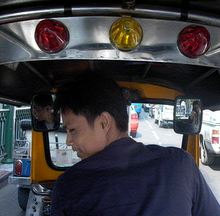Jakarta Post, Opinion and Editorial, January 21, 2006.
A home should be a safe abode, thus security is important. A common solution to the security of Jakartan houses is to put bars on the windows facing the street. After the May 1998 riots, the use of security bars has proliferated, with all open spaces being covered, making their occupants feel caged in their own homes. Housing complexes that have been developed over the past ten years are more likely to be surrounded by three-meter walls, and can only be entered through secured gates.
Older middle-upper housing complexes, on the other hand, are not gated. I will argue that it is precisely this openness and inclusivity towards other racial, social and economic groups, that has strengthened social security.
Gated communities aim to exclude "others". Most of them don't allow street vendors and those who "don't belong" to enter the complexes. Caged-in houses can even be found within these complexes. It seems that the fear of "others", traditionally addressed towards those of a different race, social or economic status, has extended itself to become a generalized fear of everyone, period. The implication of gated communities is that they create pronounced social, economic and, in most cases, racial enclaves, that are in fact far more likely to trigger resentment and thus cause insecurity.
Mike Davis in City of Quartz (1990) suggests two reasons for explaining the phenomena of house fortresses in Los Angeles. "In the first place, the market provision of 'security' generates its own paranoid demand. 'Security' becomes a ... prestige symbol. Secondly, as William Whyte has observed of social intercourse in New York, 'fear proves itself'. The social perception of threat becomes a function of the security mobilization itself, not crime rates." Post-1998 housing complexes in Jakarta reveal similar paranoia, with security becoming a commodity rather than a real need against crime.
Older middle-upper housing complexes, such as Menteng, Kemang, and Permata Hijau, have no clear boundaries with plenty of open pedestrian and vehicular access to the surrounding (kampung) areas. According to David Hutama, an architect in Jakarta, the areas of Pulomas, Kayu Putih, Taman Buaran Indah and Bintaro are also ungated, and remain this way to this day.
Occupants of these complexes, although mostly from middle and upper social and economic groups, are racially mixed. Permata Hijau is considered by many as one of the most prestigious housing areas in Jakarta. Yet, here and there, smack right up against huge, multi-billion-rupiah houses, are informal settlements ranging from low-income houses, warung, and informal businesses.
Some security measures are taken. Security posts can be found at almost every other intersection, some streets are closed off after 10 p.m., and some houses even have their own security guards. But apart from that, Permata Hijau streets are open to kaki lima and kampung dwellers, some of whom work in or provide services to these houses, while others simply hang out. Some of the streets and vacant lots are even appropriated as public space where kampung dwellers play soccer or volleyball, while others are privately used as gardens maintained by kampung dwellers.
The welcoming stance towards the kampung dwellers brings a sense of belonging to the area that in fact helps prevent crime.
Clearly, securing our homes can be done effectively without the need to live in a fortress. Jane Jacobs proposed in The Death and Life of Great American Cities (1961) that the problem of insecurity can be solved by three means.
First, there must be a clear demarcation between what is public space and what is private space.
Second, there must be eyes upon the street; eyes belonging to those who we might call the natural proprietors of the street.
And third, sidewalks must be in continuous use by pedestrians.
As most houses are gated anyway, demarcation of public and private space is already clear in most cases. However, if you happen to drive through any of the newer housing complexes, the streets are almost vacant. Gated communities create a environment that alienates and excludes others.
This is not the case in Permata Hijau, and most other older housing areas, where the inclusion of dwellers has created natural proprietors who use the streets fairly continuously, and whose "eyes" are always present.
These older complexes demonstrate that it is not necessary to exclude pre-existing and surrounding communities. Moreover, open complexes create mutual benefits for both dwellers of the housing complexes and those from surrounding communities.
Subscribe to:
Post Comments (Atom)




1 comment:
well, i don't have too much experience of jkt. but last summer i was in slipi with my lil sis.
we decided to walk to my pal's place down the road, instead of calling them to pick us up or whatever - typical westerners wanting to walk everywhere :)
i dunno, it was a 20min walk. Little or no footpath, cars whizzing by on the main road beside us. when we got to slipi raya mall we spent sometime outside, in and around the market area. ppl were coming up to us talking to us, shaking our hands, warning us about pickpockets (we /were/ careful, but it seemed that they were kinda looking out for us).
-- compare that to the greetings u get in taman anggrek mal!
so, my mini thesis, based on a little experience like that is, that there /are/ eyes on the street, ppl /do/ look out for each other, there /are/ public spaces of a sort -- it's just that wealthy folk miss them as they go to the super malls in their cars.
i'm sorry for them them.
Post a Comment